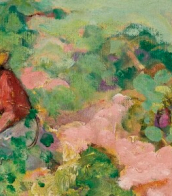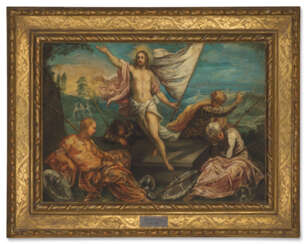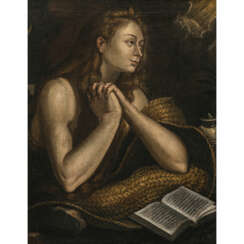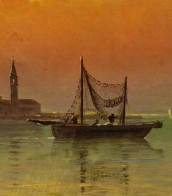robusti


 Тинторетто. Автопортрет. 1588.jpg)
Jacopo Robusti Tintoretto was an Italian painter, a significant figure in the Venetian school, and one of the most notable artists of the late Renaissance. Born in Venice in 1518, Tintoretto was known for his rapid painting technique and bold brushwork, which both fascinated and sparked debate among his contemporaries. His early aspirations were evident when he was briefly apprenticed to Titian, a relationship that ended abruptly due to a clash of personalities or Titian's possible jealousy of Tintoretto's talent. Despite this setback, Tintoretto's self-driven studies, particularly his admiration for Michelangelo's drawing and Titian's coloring, shaped his artistic development.
Tintoretto's body of work is distinguished by its dramatic gestures and muscular figures, set in dynamic compositions with a masterful use of perspective and lighting, hallmarks of the Mannerist style. His paintings are celebrated for their emotional intensity and theatricality, elements that prefigured the Baroque movement. Among his numerous contributions to art and culture, Tintoretto's work in the Scuola Grande di San Rocco in Venice stands out, showcasing his skill in creating narrative and spiritual depth across a vast series of canvases dedicated to biblical stories and the life of Christ.
Significant works by Tintoretto include "The Last Supper" at San Giorgio Maggiore, which exemplifies his innovative approach to this traditional religious subject, and "The Miracle of the Slave," demonstrating his ability to convey divine intervention with dynamic realism. His legacy extends beyond his death in 1594, with his influence resonating in the works of later artists and contributing to the development of Baroque art.
Tintoretto's dedication to his craft and his unique approach to painting made him a pivotal figure in the transition from the Renaissance to the Baroque period. His works are housed in prestigious museums and galleries worldwide, continuing to inspire and captivate audiences with their intensity and beauty.
For collectors and experts in art and antiques, Tintoretto's oeuvre represents not only a high point of Venetian painting but also a bridge between eras in art history. His innovative techniques and expressive style offer rich insights into the evolving aesthetics of his time.
To stay updated on exhibitions, sales, and auction events related to Jacopo Robusti Tintoretto's work, signing up for updates is recommended. This subscription ensures access to the latest information on available pieces and upcoming showcases, tailored specifically to enthusiasts of Tintoretto's groundbreaking contributions to art and culture.


 Тинторетто. Автопортрет. 1588.jpg)
Jacopo Robusti Tintoretto was an Italian painter, a significant figure in the Venetian school, and one of the most notable artists of the late Renaissance. Born in Venice in 1518, Tintoretto was known for his rapid painting technique and bold brushwork, which both fascinated and sparked debate among his contemporaries. His early aspirations were evident when he was briefly apprenticed to Titian, a relationship that ended abruptly due to a clash of personalities or Titian's possible jealousy of Tintoretto's talent. Despite this setback, Tintoretto's self-driven studies, particularly his admiration for Michelangelo's drawing and Titian's coloring, shaped his artistic development.
Tintoretto's body of work is distinguished by its dramatic gestures and muscular figures, set in dynamic compositions with a masterful use of perspective and lighting, hallmarks of the Mannerist style. His paintings are celebrated for their emotional intensity and theatricality, elements that prefigured the Baroque movement. Among his numerous contributions to art and culture, Tintoretto's work in the Scuola Grande di San Rocco in Venice stands out, showcasing his skill in creating narrative and spiritual depth across a vast series of canvases dedicated to biblical stories and the life of Christ.
Significant works by Tintoretto include "The Last Supper" at San Giorgio Maggiore, which exemplifies his innovative approach to this traditional religious subject, and "The Miracle of the Slave," demonstrating his ability to convey divine intervention with dynamic realism. His legacy extends beyond his death in 1594, with his influence resonating in the works of later artists and contributing to the development of Baroque art.
Tintoretto's dedication to his craft and his unique approach to painting made him a pivotal figure in the transition from the Renaissance to the Baroque period. His works are housed in prestigious museums and galleries worldwide, continuing to inspire and captivate audiences with their intensity and beauty.
For collectors and experts in art and antiques, Tintoretto's oeuvre represents not only a high point of Venetian painting but also a bridge between eras in art history. His innovative techniques and expressive style offer rich insights into the evolving aesthetics of his time.
To stay updated on exhibitions, sales, and auction events related to Jacopo Robusti Tintoretto's work, signing up for updates is recommended. This subscription ensures access to the latest information on available pieces and upcoming showcases, tailored specifically to enthusiasts of Tintoretto's groundbreaking contributions to art and culture.




 Тинторетто. Автопортрет. 1588.jpg)
Jacopo Robusti Tintoretto was an Italian painter, a significant figure in the Venetian school, and one of the most notable artists of the late Renaissance. Born in Venice in 1518, Tintoretto was known for his rapid painting technique and bold brushwork, which both fascinated and sparked debate among his contemporaries. His early aspirations were evident when he was briefly apprenticed to Titian, a relationship that ended abruptly due to a clash of personalities or Titian's possible jealousy of Tintoretto's talent. Despite this setback, Tintoretto's self-driven studies, particularly his admiration for Michelangelo's drawing and Titian's coloring, shaped his artistic development.
Tintoretto's body of work is distinguished by its dramatic gestures and muscular figures, set in dynamic compositions with a masterful use of perspective and lighting, hallmarks of the Mannerist style. His paintings are celebrated for their emotional intensity and theatricality, elements that prefigured the Baroque movement. Among his numerous contributions to art and culture, Tintoretto's work in the Scuola Grande di San Rocco in Venice stands out, showcasing his skill in creating narrative and spiritual depth across a vast series of canvases dedicated to biblical stories and the life of Christ.
Significant works by Tintoretto include "The Last Supper" at San Giorgio Maggiore, which exemplifies his innovative approach to this traditional religious subject, and "The Miracle of the Slave," demonstrating his ability to convey divine intervention with dynamic realism. His legacy extends beyond his death in 1594, with his influence resonating in the works of later artists and contributing to the development of Baroque art.
Tintoretto's dedication to his craft and his unique approach to painting made him a pivotal figure in the transition from the Renaissance to the Baroque period. His works are housed in prestigious museums and galleries worldwide, continuing to inspire and captivate audiences with their intensity and beauty.
For collectors and experts in art and antiques, Tintoretto's oeuvre represents not only a high point of Venetian painting but also a bridge between eras in art history. His innovative techniques and expressive style offer rich insights into the evolving aesthetics of his time.
To stay updated on exhibitions, sales, and auction events related to Jacopo Robusti Tintoretto's work, signing up for updates is recommended. This subscription ensures access to the latest information on available pieces and upcoming showcases, tailored specifically to enthusiasts of Tintoretto's groundbreaking contributions to art and culture.



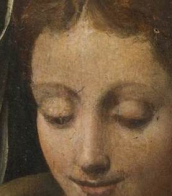

Martin Noel is a contemporary German painter and graphic artist.

 Тинторетто. Автопортрет. 1588.jpg)
Jacopo Robusti Tintoretto was an Italian painter, a significant figure in the Venetian school, and one of the most notable artists of the late Renaissance. Born in Venice in 1518, Tintoretto was known for his rapid painting technique and bold brushwork, which both fascinated and sparked debate among his contemporaries. His early aspirations were evident when he was briefly apprenticed to Titian, a relationship that ended abruptly due to a clash of personalities or Titian's possible jealousy of Tintoretto's talent. Despite this setback, Tintoretto's self-driven studies, particularly his admiration for Michelangelo's drawing and Titian's coloring, shaped his artistic development.
Tintoretto's body of work is distinguished by its dramatic gestures and muscular figures, set in dynamic compositions with a masterful use of perspective and lighting, hallmarks of the Mannerist style. His paintings are celebrated for their emotional intensity and theatricality, elements that prefigured the Baroque movement. Among his numerous contributions to art and culture, Tintoretto's work in the Scuola Grande di San Rocco in Venice stands out, showcasing his skill in creating narrative and spiritual depth across a vast series of canvases dedicated to biblical stories and the life of Christ.
Significant works by Tintoretto include "The Last Supper" at San Giorgio Maggiore, which exemplifies his innovative approach to this traditional religious subject, and "The Miracle of the Slave," demonstrating his ability to convey divine intervention with dynamic realism. His legacy extends beyond his death in 1594, with his influence resonating in the works of later artists and contributing to the development of Baroque art.
Tintoretto's dedication to his craft and his unique approach to painting made him a pivotal figure in the transition from the Renaissance to the Baroque period. His works are housed in prestigious museums and galleries worldwide, continuing to inspire and captivate audiences with their intensity and beauty.
For collectors and experts in art and antiques, Tintoretto's oeuvre represents not only a high point of Venetian painting but also a bridge between eras in art history. His innovative techniques and expressive style offer rich insights into the evolving aesthetics of his time.
To stay updated on exhibitions, sales, and auction events related to Jacopo Robusti Tintoretto's work, signing up for updates is recommended. This subscription ensures access to the latest information on available pieces and upcoming showcases, tailored specifically to enthusiasts of Tintoretto's groundbreaking contributions to art and culture.


Paul Klee, a Swiss-born German artist, was renowned for his unique contribution to the art world, blending elements from expressionism, cubism, and surrealism. Born on December 18, 1879, in Münchenbuchsee, Switzerland, Klee was the second child of a German music teacher and a Swiss singer. Despite early musical talent, Klee pursued visual arts, influenced by a dissatisfaction with the state of modern music and a desire for creative freedom.
Klee's artistic journey began in earnest after he decided against a career in music, despite his exceptional skills with the violin. His education at the Academy of Fine Arts in Munich under the guidance of Heinrich Knirr and Franz von Stuck was crucial in shaping his artistic direction. Although he struggled with color initially, Klee later became a master of color theory, a transition marked by his transformative visit to Tunisia in 1914. This trip was a pivotal moment, leading Klee to declare, "Color and I are one. I am a painter".
Throughout his career, Klee's work was characterized by a profound sense of experimentation and innovation. He explored the boundaries of abstract art, drawing inspiration from his vast interests, including literature, music, and his own theories on art and aesthetics. His lectures on form and design theory at the Bauhaus, where he taught alongside luminaries like Wassily Kandinsky, are considered as seminal to modern art as Leonardo da Vinci's treatises were to the Renaissance.
Klee's art is celebrated for its intricacy, humor, and the ability to express complex themes through seemingly simplistic and childlike forms. His notable works, such as "Twittering Machine" (1922) and "Highway and Byways" (1928), showcase his skill in using color, shape, and line to evoke depth and emotion.
For collectors and art and antiques experts, Klee's legacy is a testament to the power of innovation and the search for personal expression within the avant-garde movements of the 20th century. His works, housed in prestigious museums and galleries around the world, continue to inspire and intrigue.
If you're passionate about art and wish to stay informed about new discoveries and sales related to Paul Klee's works, consider signing up for updates. This subscription will ensure you're alerted to upcoming auction events and product sales, allowing you to deepen your collection and appreciation of this remarkable artist's legacy.
